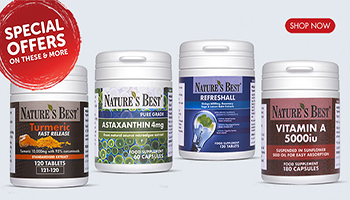
To keep your eyes healthy, it’s important to eat a healthy diet – particularly one rich in substances called antioxidants.i But what are antioxidants exactly, and where can you find them? To help you to understand the impact of antioxidants on eye health a little better, we’ve put together this helpful guide.
What are antioxidants?
Antioxidants are molecules that are made in the body and found in our diet. They’re considered important for health because of the way they protect us against the damaging effects of chemicals called free radicals. These are harmful chemicals produced when our bodies turn food into energy, during exercise, when we’re exposed to things like cigarette smoke and sunlight or parts of our bodies are affected by inflammation. Free radicals cause damage by stealing electrons from other molecules in our bodies, resulting in reactions that scientists call oxidative stress. This can alter the function of the affected molecules, causing damage to your DNA as well as other cell structures, which is why free radical damage is thought to be involved in a number of eye diseases, including age-related macular degeneration and vision loss.

Antioxidants, on the other hand, are thought to protect the body against oxidation by ‘feeding’ their own electrons to free radicals. There are hundreds or possibly even thousands of substances that act as antioxidants. Your body makes some of them itself, but many more are found in a wide range of foods.
Which antioxidants support eye health?
With so many antioxidants available both in food and in nutritional supplements, selecting the right ones to support eye health can be overwhelming. To make this a little easier, we’ve compiled a list of the main antioxidants for eye health, explaining how they may help to keep your vision healthy.
Vitamin A
This fat-soluble antioxidant vitamin is actually a group of substances called retinoids, including retinol, retinal and retinyl esters. Vitamin A is considered as essential for good vision because it’s found in cells in your eyes called photoreceptors. Vitamin A also supports the functioning of the conjunctival membranes and corneas. If you’re deficient in vitamin A, one of the complications can be night blindness. On top of this, dry eyes may also be a sign that you’re not getting enough vitamin A into your diet.
What’s the evidence?
The AREDS study looked into the effects of vitamins on eye health.ii After five years of taking a multivitamin supplement containing beta-carotene (a vitamin A substance) along with vitamin C, vitamin E and zinc, participants were 25% less likely to experience age-related macular degeneration (AMD) compared with a placebo group. Although the researchers weren’t able to say if the effect was the result of just one or any particular combination of nutrients, there is certainly support for supplementation in supporting eye health.
Another study also found that increasing vitamin A in your diet may be linked with another common eye health condition called cataracts iii, while elsewhere researchers have suggested taking beta-carotene supplements may help prevent cataracts in people who smoke iv. There is also some evidence that vitamin A may help reduce the risk of another eye condition that causes vision loss called glaucoma v.
Where to find it
Vitamin A is only found in animal-derived foods such as liver, dairy, egg yolks and cod liver oil. However, you can also get vitamin A from other antioxidant substances such as beta-carotene and provitamin A carotenoids, as these are converted to vitamin A in the body. Provitamin A carotenoids such as beta-carotene are found in plant foods including green leafy vegetables, orange and yellow vegetables, tomatoes, some fruits and some vegetable oils, with some top sources including carrots, broccoli, cantaloupe melon and squash.
Vitamin C
Also known as ascorbic acid, vitamin C is a water-soluble antioxidant vitamin that’s found naturally in a number of foods. It’s needed for a variety of processes in the body and has an important role to play in immune function. It is also thought to help keep the blood vessels in your eyes healthy and is found in high concentrations in the aqueous humour of the eye – the liquid that fills the outermost part of the eye.
What’s the evidence?
Vitamin C was one of the nutrients included in the AREDS study which suggested it may have a protective effect against AMD.ii Alongside being beneficial for protecting against age-related eye conditions, one study has also shown that eating more foods rich in vitamin C increases the amount found of this nutrient found in the aqueous humour of the eye.vi According to the American Optometric Association, there’s also evidence to suggest that vitamin C may lower the risk of developing cataracts.vii
Where to find it
The best sources of vitamin C are fruits and vegetables, including citrus fruits, red and green peppers, kiwifruit, tomatoes, strawberries, broccoli, spinach, potatoes and sprouts. To get the most out of these foods, it’s best to eat them raw, since their vitamin C content may be reduced in cooking.
Vitamin E
Vitamin E is the name for a group of fat-soluble antioxidant substances with names such as alpha-tocopherol, beta-tocopherol, gamma-tocopherol and delta-tocopherol. It’s thought to protect fatty acids from oxidation, including the fatty acids found in part of the eye called the retina, which converts light into signals that are sent via the optic nerve to the brain. Since the retina contains a high concentration of fatty acids, experts believe that vitamin E is particularly important for eye health and preventing retina damage.viii
What’s the evidence?
Like vitamin A and vitamin C, vitamin E was one of the nutrients found to be beneficial in reducing macular degeneration in the AREDS study.2 Elsewhere, the American Optometric Association states that vitamin E may also help to protect cells in the eyes from free radical damage.ix An analysis of observational studies suggests you may have a slightly reduced risk of cataracts if you take more than 7mg of vitamin E a day.x As such, it’s important to ensure that you begin taking steps now in order to support your eyes as you age.
Where to find it
You can find vitamin E in many foods, including nuts, seeds and vegetable oils, which are some of the best sources of alpha-tocopherol. There’s also vitamin E in leafy green vegetables such as spinach and other fruits and vegetables including kiwifruit, broccoli, mango and tomato.
Zinc
Zinc is an essential mineral that’s involved in the activity of many enzymes in the body, including the antioxidant enzyme superoxide dismutase. It’s also found in high concentrations in the eye, particularly in the retina and the choroid, which is the layer of tissue below the retina. As such, zinc may be important for eye health because it helps your body to absorb vitamin A.
What’s the evidence?
Zinc is another beneficial nutrient included in the AREDS study, as well as a follow-up study called AREDS2.xii Both of these studies found a supplement containing a combination of nutrients including zinc helped to reduce the progression of advanced AMD. In addition to this, another study looked into the effects of zinc on its own and found it helped to slow down the progress of early-stage AMD in older people.xii
Where to find it
Because your body doesn’t store zinc, you need a steady supply of it in order to experience the full effects. The best source is oysters, though most people take it in from more accessible foods such as red meat, poultry, certain types of seafood, beans, nuts, whole grains and dairy products. Given the importance of keeping your zinc levels high, it might be worth considering a high-quality zinc supplement or any easy-to-chew lozenge.
Lutein and zeaxanthin
Natural antioxidants belonging to the carotenoid family of plant pigments, both lutein and zeaxanthin are considered to be powerful antioxidants for supporting heart health. Along with a related antioxidant substance called meso-zeaxanthin – which is thought to be made in the body from lutein – they are found in very high concentrations in the part of the eye called the macula and are thought to help protect the eye from light damage.
What’s the evidence?
Studies show lutein and zeaxanthin may lower your risk of AMD because they protect the macula against sun damage.xiii Several trials have also found that lutein and zeaxanthin may be useful if your level of protective pigments found in the macula is particularly low.xiv As well as this, other researchers have discovered those who eat foods containing lutein are less likely to develop age-related conditions such as cataracts. But the benefits are not just found in older eyes. One study also found that lutein and zeaxanthin may help reduce headaches and eye strain in those who spend long periods of time in front of a computer, such as office workers.xvi Learn more about how lutein and zeaxanthin can assist with eye health in our article.
Where to find them
These antioxidants are often found together in nature, with plant foods rich in lutein often also containing zeaxanthin though usually in smaller amounts. Both nutrients are found in a variety of foods, including green leafy plants and other colourful fruits and vegetables. To find out more, see our guide to foods that contain lutein and zeaxanthin: eating for eye health.
Antioxidants, as we’ve discovered, could help to protect your eyes form a range of conditions. Want to find discover even more information on eye health? You can find a range of helpful articles on our Vision Health Hub.
References:
-
American Optometric Association. Diet and Nutrition. Available online: https://www.aoa.org/patients-and-public/caring-for-your-vision/diet-and-nutrition
-
National Eye Institute. Age-Related Eye Disease Study. Available online: https://www.nei.nih.gov/amd
-
Cumming, R.G., Mitchel, P., Smith, W. Diet and cataract: the Blue Mountains Eye Study. Ophthalmology. (2000 Mar). ;107(3):450-6. Available online: https://www.ncbi.nlm.nih.gov/pubmed/10711880?dopt=Abstract
-
Christen, W.G., Manson, J.E., Glynn , R.J., et al. The role of anti-inflammatory agents in age-related macular degeneration (AMD) treatment. Arch Ophthalmol. (2003) ;121:372-378.
-
Bussel, I.I, Aref, A.A. Dietary factors and the risk of glaucoma: a review. Ther Adv Chronic Dis. (2014) ;5(4):188-194. Available online: https://www.ncbi.nlm.nih.gov/pubmed/24982753
-
Taylor, A, et al. Relationship in humans between ascorbic acid consumption and levels of total and reduced ascorbic acid in lens, aqueous humor, and plasma. Curr Eye Res. (1991 Aug) ;10(8):751-9. Available online: https://www.ncbi.nlm.nih.gov/pubmed/1914507
-
American Optometric Association. Vitamin C. Available online: https://www.aoa.org/patients-and-public/caring-for-your-vision/diet-and-nutrition/vitamin-c
-
SanGiovanni, J.P., Chew, E.Y. The role of omega-3 long-chain polyunsaturated fatty acids in health and disease of the retina. Prog Retin Eye Res. (2005 Jan) ;24(1):87-138. Available online: https://www.ncbi.nlm.nih.gov/pubmed/15555528
-
https://www.aoa.org/patients-and-public/caring-for-your-vision/diet-and-nutrition?sso=y
-
Zhang, Y., et al. Vitamin E and risk of age-related cataract: a meta-analysis. Public Health Nutr. (2015 Oct) ;18(15):2804-14. Available online: https://www.ncbi.nlm.nih.gov/pubmed/25591715
-
AREDS2 Research Group,, Chew, E.Y., Clemons, T., et al. The Age-Related Eye Disease Study 2 (AREDS2): study design and baseline characteristics (AREDS2 report number 1). Ophthalmology. (2012) ;119(11):2282-2289. Available online: https://www.ncbi.nlm.nih.gov/pmc/articles/PMC3485447
-
Newsome, D.A., et al. Oral zinc in macular degeneration. Arch Ophthalmol. (1988 Feb) ;106(2):192-8. Available online: https://www.ncbi.nlm.nih.gov/pubmed/3277606
-
Landrum, J.T., Bone, R.A., Kilburn, M.D. The macular pigment: a possible role in protection from age-related macular degeneration. Adv Pharmacol. (1997) ;38:537-556. Available online: https://www.ncbi.nlm.nih.gov/pubmed/8895823
Hammond, B.R Jr., Wooten, B.R., Snodderly, D.M. Density of the human crystalline lens is related to the macular pigment carotenoids, lutein and zeaxanthin. Optom Vis Sci. (1997) ;74:499-504. Available online: https://www.ncbi.nlm.nih.gov/pubmed/9293517 -
Obana, A., et al. Changes in Macular Pigment Optical Density and Serum Lutein Concentration in Japanese Subjects Taking Two Different Lutein Supplements. PLoS One. (2015 Oct 9) ;10(10):e0139257. Available online: https://www.ncbi.nlm.nih.gov/pubmed/26451726
-
Richer, S., et al. Double-masked, placebo-controlled, randomized trial of lutein and antioxidant supplementation in the intervention of atrophic age-related macular degeneration: the Veterans LAST study (Lutein Antioxidant Supplementation Trial). Optometry. (2004 Apr) ;75(4):216-30. Available online: https://www.ncbi.nlm.nih.gov/pubmed/15117055
-
Hankinson, S.E., Stampfer, M.J., Seddon, J.M., et al. Nutrient intake and cataract extraction in women: a prospective study. BMJ. (1992) ;305:335-339. Available online: https://www.ncbi.nlm.nih.gov/pubmed/1392884
-
Stringham, J.M., Stringham, N.T, O’Brien, K.J. Macular Carotenoid Supplementation Improves Visual Performance, Sleep Quality, and Adverse Physical Symptoms in Those with High Screen Time Exposure. Foods. (2017 Jun 29) ;6(7). Available online: https://www.ncbi.nlm.nih.gov/pubmed/28661438
Related Posts?
Disclaimer: The information presented by Nature's Best is for informational purposes only. It is based on scientific studies (human, animal, or in vitro), clinical experience, or traditional usage as cited in each article. The results reported may not necessarily occur in all individuals. Self-treatment is not recommended for life-threatening conditions that require medical treatment under a doctor's care. For many of the conditions discussed, treatment with prescription or over the counter medication is also available. Consult your doctor, practitioner, and/or pharmacist for any health problem and before using any supplements or before making any changes in prescribed medications.

Christine
Christine Morgan has been a freelance health and wellbeing journalist for almost 20 years, having written for numerous publications including the Daily Mirror, S Magazine, Top Sante, Healthy, Woman & Home, Zest, Allergy, Healthy Times and Pregnancy & Birth; she has also edited several titles such as Women’ Health, Shine’s Real Health & Beauty and All About Health.
View More



